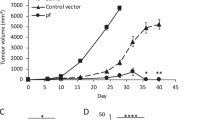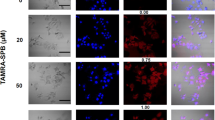Abstract
SV40 vectors packaged in vitro (pseudovirions) are an efficient delivery system for plasmids up to 17.7 kb, with or without SV40 sequences. A truncated Pseudomonas exotoxin gene (PE38) was delivered into various human cells (HeLa, KB-3-1, human lymphoblastoids, and erythroleukemia cells), in vitro using pseudovirions. The number of viable cells was reduced significantly in the PE38-transduced cells. Human KB adenocarcinomas growing in mice were treated with intratumoral injection of PE38 packaged in vitro, and tumor size decreased significantly. Intraperitoneal treatments were as effective in reducing tumor size as intratumoral treatments. To check the viability of mock- or PE38-treated mice, every 4 days they were weighed, their blood was tested, and various tissues were screened for pathology. All parameters showed that the in vitro-packaged vectors, injected into tumors or intraperitoneally, caused no abnormalities in mice. The combined treatment of doxorubicin with in vitro-packaged PE38 reduced tumor size slightly more than each of the treatments separately. However, the combined treatment did not cause the weight loss seen with doxorubicin alone. These results indicate that SV40 in vitro packaging is an effective system for cancer gene delivery using two different routes of injection and in combination with chemotherapy.
This is a preview of subscription content, access via your institution
Access options
Subscribe to this journal
Receive 12 print issues and online access
$259.00 per year
only $21.58 per issue
Buy this article
- Purchase on Springer Link
- Instant access to full article PDF
Prices may be subject to local taxes which are calculated during checkout







Similar content being viewed by others
References
Pastan I . Immunotoxins containing Pseudomonas exotoxin A: a short history. Cancer Immunol Immunother 2003; 52: 338–341.
Chen TY, Shang HF, Chen TL, Lin CP, Hui CF, Hwang J . Recombinant protein composed of Pseudomonas exotoxin A, outer membrane proteins I and F as a vaccine against P. aeruginosa infection. Biomed Sci 1999; 6: 727–732.
Fitzgerald D, Pastan I . Pseudomonas exotoxin and recombinant immunotoxins derived from it. Ann NY Acad Sci 1993; 685: 740–745.
Brinkmann U, Reiter Y, Jung SH, Lee B, Pastan I . A Recombinant immunotoxin containing a disulfide-stabilized Fv fragment. Proc Natl Acad Sci USA 1993; 90: 7538–7542.
Bera TK, Onda M, Brinkmann U, Pastan I . A Bivalent disulfide-stabilized Fv with improved antigen binding to erbB2. J Mol Biol 1998; 281: 475–483.
Kreitman RJ, Wilson WH, Bergeron K, Raggio M, Stetler-Stevenson M, FitzGerald DJ et al. Efficacy of the anti-CD22 recombinant immunotoxin BL22 in chemotherapy-resistant hairy-cell leukemia. N Eng J Med 2001; 345: 241–247.
Vassaux G, Martin-Duque P . Use of suicide genes for cancer gene therapy: study of the different approaches. Expert Opin Biol Ther 2004; 4: 519–530.
Yazawa K, Fisher WE, Brunicardi FC . Current progress in suicide gene therapy for cancer. World J Surg 2002; 26: 783–789.
Gottesman MM . Cancer gene therapy: an awkward adolescence. Cancer Gene Ther 2003; 10: 501–508.
Ogris M, Wagner E . Targeting tumors with non-viral gene delivery systems. Drug Discov Today 2002; 7: 479–485.
Kimchi-Sarfaty C, Ben-Nun-Shaul O, Rund D, Oppenheim A, Gottesman MM . In vitro-packaged SV40 Pseudovirions as highly efficient vectors for gene transfer. Hum Gene Ther 2002; 13: 299–310.
Kimchi-Sarfaty C, Arora M, Sandalon Z, Oppenheim A, Gottesman MM . High cloning capacity of in vitro packaged SV40 vectors with no SV40 virus sequences. Hum Gene Ther 2003; 14: 167–177.
Kimchi-Sarfaty C, Gottesman MM . SV40 pseudovirions as highly efficient vectors for gene transfer and their potential application in cancer therapy. Curr Pharm Biotechnol 2004; 5: 451–458.
Sandalon Z, Dalyot-Herman N, Oppenheim AB, Oppenheim A . In vitro assembly of SV40 virions and pseudovirions: vector development for gene therapy. Hum Gene Ther 1997; 8: 843–849.
Sandalon Z, Oppenheim A . Self-assembly and protein-protein interactions between the SV40 capsid proteins produced in insect cells. Virology 1997; 237: 414–421.
Hafkemeyer P, Brinkmann U, Gottesman MM, Pastan I . Apoptosis induced by Pseudomonas exotoxin: a sensitive and rapid marker for gene delivery in vivo. Hum Gene Ther 1999; 10: 923–934.
Kimchi-Sarfaty C, Alexander NS, Brittain S, Ali S, Gottesman MM . Transduction of multiple cell types using improved conditions for gene delivery and expression of SV40 pseudovirions packaged in vitro. BioTechniques 2004; 37: 270–275.
Akiyama S, Fojo A, Hanover JA, Pastan I, Gottesman MM . Isolation and genetic characterization of human KB cell lines resistant to multiple drugs. Somat Cell Mol Genet 1985; 11: 117–126.
Gottesman MM, Germann UA, Aksentijevich I, Sugimoto Y, Cardarelli CO, Pastan I . Gene transfer of drug resistance genes. Implications for cancer therapy. Ann NY Acad Sci 1994; 716: 126–138; discussion 138-143.
Chaudhary VK, Jinno Y, Gallo MG, FitzGerald D, Pastan I . Mutagenesis of Pseudomonas exotoxin in identification of sequences responsible for the animal toxicity. J Biol Chem 1990; 265: 16306–16310.
FitzGerald DJ, Kreitman R, Wilson W, Squires D, Pastan I . Recombinant immunotoxins for treating cancer. Int J Med Microbiol 2004; 293: 577–582.
Kreitman RJ, Bailon P, Chaudhary VK, FitzGerald DJ, Pastan I . Recombinant immunotoxins containing anti-Tac(Fv) and derivatives of Pseudomonas exotoxin produce complete regression in mice of an interleukin-2 receptor-expressing human carcinoma. Blood 1994; 83: 426–434.
Kreitman RJ, Chaudhary VK, Waldmann T, Willingham MC, FitzGerald DJ, Pastan I . The recombinant immunotoxin anti-Tac(Fv)-Pseudomonas exotoxin 40 is cytotoxic toward peripheral blood malignant cells from patients with adult T-cell leukemia. Proc Natl Acad Sci USA 1990; 87: 8291–8295.
Beseth BD, Cameron RB, Leland P, You L, Varricchio F, Kreitman RJ et al. Interleukin-4 receptor cytotoxin as therapy for human malignant pleural mesothelioma xenografts. Ann Thorac Surg 2004; 78: 436–443.
Kawakami M, Kawakami K, Kioi M, Leland P, Puri RK . Hodgkin's lymphoma therapy with interleukin-4 receptor-directed cytotoxin in an infiltrating animal model. Blood 2004; 105: 3707–3713.
Kioi M, Kawakami K, Puri RK . Analysis of antitumor activity of an interleukin-13 (IL-13) receptor-targeted cytotoxin composed of IL-13 antagonist and Pseudomonas exotoxin. Clin Cancer Res 2004; 10 (Part 1): 6231–6238.
Vallera DA, Jin N, Shu Y, Panoskaltsis-Mortari A, Kelekar A, Chen W . Retroviral immunotoxin gene therapy of leukemia in mice using leukemia-specific T cells transduced with an interleukin-3/Bax fusion protein gene. Hum Gene Ther 2003; 14: 1787–1798.
Jain KK . Use of bacteria as anticancer agents. Expert Opin Biol Ther 2001; 1: 291–300.
Theuer CP, FitzGerald DJ, Pastan I . A recombinant form of Pseudomonas exotoxin A containing transforming growth factor alpha near its carboxyl terminus for the treatment of bladder cancer. J Urol 1993; 149: 1626–1632.
Xu YM, Wang LF, Jia LT, Qiu XC, Zhao J, Yu CJ et al. A caspase-6 and anti-human epidermal growth factor receptor-2 (HER2) antibody chimeric molecule suppresses the growth of HER2-overexpressing tumors. J Immunol 2004; 173: 61–67.
Kawakami M, Kawakami K, Puri RK . Interleukin-4-Pseudomonas exotoxin chimeric fusion protein for malignant glioma therapy. J Neurooncol 2003; 65: 15–25.
Kreitman RJ, Puri RK, Pastan IA . Circularly permuted recombinant interleukin 4 toxin with increased activity. Proc Natl Acad Sci USA 1994; 91: 6889–6893.
Chen TY, Hsu CT, Chang KH, Ting CY, Whang-Peng J, Hui CF et al. Development of DNA delivery system using Pseudomonas exotoxin A and a DNA binding region of human DNA topoisomerase I. Appl Microbiol Biotechnol 2000; 53: 558–567.
Yerushalmi N, Brinkmann U, Brinkmann E, Pai L, Pastan I . Attenuating the growth of tumors by intratumoral administration of DNA encoding Pseudomonas exotoxin via cationic liposomes. Cancer Gene Ther 2000; 7: 91–96.
Jakubzick C, Kunkel SL, Puri RK, Hogaboam CM . Therapeutic targeting of IL-4- and IL-13-responsive cells in pulmonary fibrosis. Immunol Res 2004; 30: 339–349.
Kimchi-Sarfaty C, Garfield S, Alexander NS, Ali S, Cruz C, Chinnasamy D et al. The pathway of uptake of SV40 pseudovirions packaged in vitro: from MHC class I receptors to the nucleus. Gene Ther Mol Biol 2004; 8: 439–450.
Cogan PS, Koch TH . Studies of targeting and intracellular trafficking of an anti-androgen doxorubicin-formaldehyde conjugate in PC-3 prostate cancer cells bearing androgen receptor-GFP chimera. J Med Chem 2004; 47: 5690–5699.
Acknowledgements
This research was supported by the Intramural Research Program of the National Institutes of Health, National Cancer Institute, Center for Cancer Research. We thank Ariella Oppenheim (The Hebrew University, Hadassah Medical School and Hadassah University Hospital, Jerusalem, Israel) for fruitful collaboration on the SV40 vectors, and Ira Pastan, LMB, NIH for productive discussions. We thank Georgina F Miller and Michael Eckhaus, ORS/DIRS/VRP, NIH, for providing us with pathological reports and blood tests results, and George Leiman for insightful editorial assistance.
Author information
Authors and Affiliations
Corresponding author
Rights and permissions
About this article
Cite this article
Kimchi-Sarfaty, C., Vieira, W., Dodds, D. et al. SV40 Pseudovirion gene delivery of a toxin to treat human adenocarcinomas in mice. Cancer Gene Ther 13, 648–657 (2006). https://doi.org/10.1038/sj.cgt.7700943
Received:
Revised:
Accepted:
Published:
Issue Date:
DOI: https://doi.org/10.1038/sj.cgt.7700943
Keywords
This article is cited by
-
PE38-based gene therapy of HER2-positive breast cancer stem cells via VHH-redirected polyamidoamine dendrimers
Scientific Reports (2021)
-
Effects of HPV Pseudotype Virus in Cutting E6 Gene Selectively in SiHa Cells
Current Medical Science (2018)
-
Simian virus 40 vectors for pulmonary gene therapy
Respiratory Research (2007)



